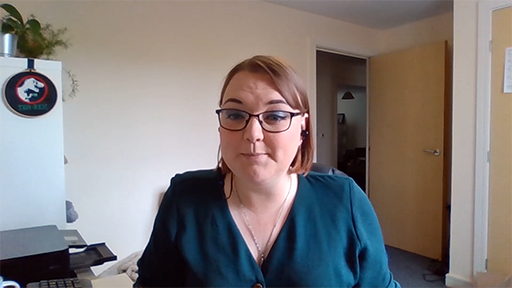2.6 Empathy
What is empathy? Many of us think of it as a bit of a fluffy, fuzzy, ‘feel-good emotion’ or relate it to being kind and emotionally sensitive. Krznaric defines it as ‘the art of stepping imaginatively into the shoes of another person, understanding their feelings and perspectives and using that to guide your actions’. It is very distinct from sympathy, as you will see later in this section.
Activity 10 What does empathy mean to you?
Before getting into this part of the course, note down what you feel is the definition of empathy and what that might look like.
Now watch this short animation from Brené Brown, for her perspective on empathy: Brené Brown on empathy [Tip: hold Ctrl and click a link to open it in a new tab. (Hide tip)] .
Understanding empathy
Think about some of the actors who famously practise the art of method acting. Through that approach they have taken the time to really understand what their character would be feeling, hearing and seeing and then used that to ‘become’ the character. Notable examples include Adrien Brody in the film The Pianist and Jim Carrey in Man on the Moon.
Patricia Moore is an example of someone who built empathy in the workplace to develop a new innovative product. She was the only female designer out of 350 men in her organisation and she asked a simple question during a design session for a new fridge: ‘couldn’t we design the door so that someone with arthritis would find it easy to open?’. She was told by a colleague ‘we don’t design for those people’, which prompted her to conduct a radical experiment in empathy (Krznaric, 2015, p. xi): she dressed up and ‘became’ an 85 year old woman. She said she didn’t want to be an actor pretending to be an elderly woman so she used theatrical makeup, clothing and a walking stick and transformed herself into an elderly woman. She kept up this persona from 1979 to 1982 and her experience gave her a first-hand understanding of how difficult it was to walk up steep stairs, use can openers and open fridges, etc. She realised that there was a gap in the market and she took product design in a new direction. Based on her insights and experiences she created products that were suitable for use by the elderly and for those with arthritis.
Expanding your empathetic potential
To cultivate a habit of being empathetic, Krznaric (2015, p. xiv) suggests the following six habits of highly empathetic people:
- Switch on your empathetic brain – Understand that empathy is core of human nature and that it can continue to develop and grow.
- Make the imaginative leap – Make a conscious effort to step into someone else’s shoes no matter who that is, whether it is friend or foe. Acknowledge their humanity, individuality and perspectives.
- Seek experiential adventures – Explore lives and cultures that are not the same as your own whether this is through direct immersion or empathetic journey mapping.
- Practice the craft of conversation – Be curious, be inquisitive, be like a child again asking questions and listen and connect. Don’t be an examiner, be the interested enquirer.
- Travel in your armchair – You cannot always go to the place to build empathy, but you can put yourself into someone else’s mind using art, literature, film and online social networks.
- Inspire a revolution – Start to generate empathy and use it to create social change and extend your empathy skills to embrace the natural world around you.
Empathy is not an easy skill to practise at work, and according to Business Solvers 2021 Empathy Study, 70% of CEOs felt that they struggled to demonstrate it at work consistently. However, empathy is a growing priority in the workplace, particularly with ‘Gen Z’ (those born in the late 1990s and early 2000s) employees, 90% of whom say they are more likely to stay in their jobs if their employer is empathetic.
Empathy vs sympathy
Empathy is very distinct from sympathy, which is more about feeling pity for someone else (Krznaric, 2015, p. x). Feeling sorry for someone is not trying to feel with them and understand their emotions or point of view, as this short animation illustrates: How empathy works – and sympathy can’t.
The table below (adapted from Waters, 2022) summarises the differences between empathy and sympathy.
| Empathy is: | Sympathy is: |
|---|---|
| feeling what someone else feels | having thoughts about what someone feels, e.g. when you feel pity or sorry for them |
| actively listening to what they have to say | when in conversation, giving unasked for advice |
| not judging | passing judgement |
| being aware of nuances and non-verbal cues | only noticing the surface-level issue |
| discovering the other person’s perspective | understanding only from your own perspective |
| acknowledging everyone’s feelings | ignoring or suppressing your emotions |
Why is empathy important?
Have you ever started to listen to someone tell you how they are feeling and then begun to offer unsolicited suggestions on what you think they should do? Watch the following video, which shows the consequences and reactions of trying to ‘fix’ your partner rather than just empathise with them.
It’s not about the nailThis is a risk with not building empathy – we try to fix and ‘solutionise’ things.
Having empathy can help you improve communication, build important relationships and it has been shown that it can reduce discrimination and unethical behaviour.
Empathy in leading hybrid teams
During the peak of the COVID-19 pandemic restrictions, the knowledge that people around the globe were facing similar challenges seemed to connect us and increase our levels of empathy. Since restrictions have eased, we have had to shift and adapt to hybrid working and try to move seamlessly between in-person and virtual work. We used to collaborate around whiteboards in an office and now we are doing this via digital tools online. The expectations remain the same even if the method and modality of working has shifted. So what can you do as a leader to develop and have empathy with your teams, even if you no longer bump into them in an office?
Activity 11 Connecting with your team to build empathy
First, watch the video in which Natasha Davies, Policy and Research Lead for Chwarae Teg, talks about how leaders can be more empathic for hybrid ways of working.

Transcript
Then read the following article for some practical tips on empathetic leadership: Leadership: How to show empathy to hybrid work teams.
Make some notes on what you find and what questions you could ask when connecting with your team to build empathy. It is a skill that takes practice and working remotely can create barriers that you may not have even thought of but you may have only thought about how productive they are instead of being measured by the visibility of being online.
